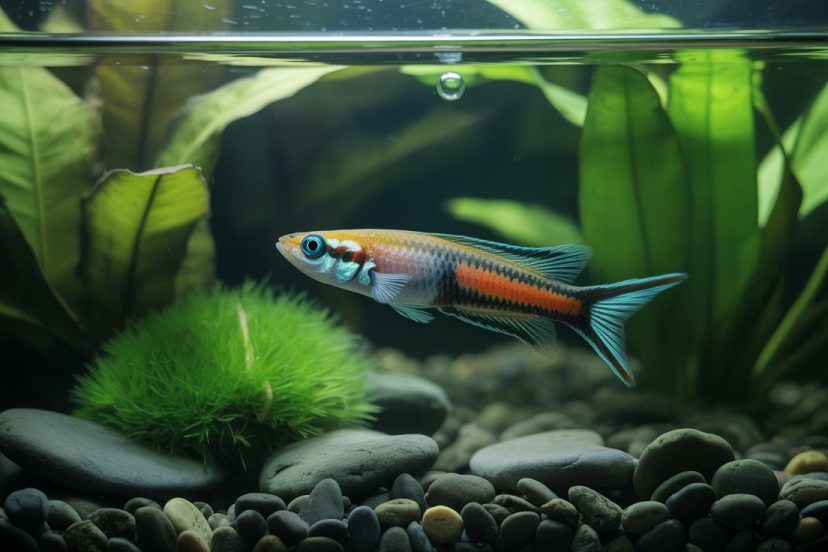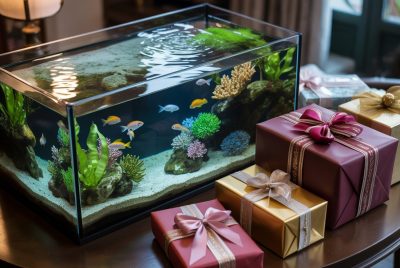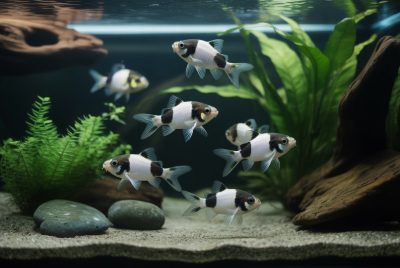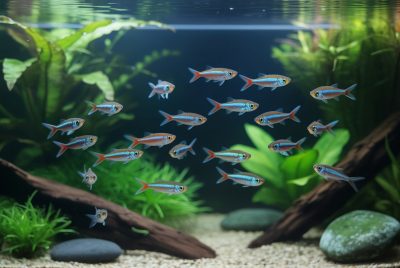Top 5 Algae-Eating Fish and Invertebrates
*We may earn a commission for purchases made using our links. Please see our disclosure to learn more.
The gentle hum of your aquarium filter creates a peaceful ambiance, but something’s not quite right. Green films creep across your glass walls, stringy masses float through the water column, and your once-pristine aquatic paradise looks more like a neglected pond. This frustrating scenario plays out in countless aquariums worldwide, leaving aquarists searching for natural, effective solutions to combat persistent algae growth.
Rather than reaching for harsh chemical treatments that can disrupt your tank’s delicate ecosystem, nature offers remarkable allies in the battle against unwanted algae. Certain fish and invertebrates have evolved specifically to consume various types of algae, transforming what many consider a nuisance into their primary food source. These living cleanup crews don’t just address algae problems—they become integral parts of a balanced, thriving aquatic ecosystem.
“A well-balanced aquarium ecosystem relies on the intricate relationships between all inhabitants, where algae-eating species serve as nature’s own maintenance crew, transforming problems into solutions.”
— Marine Biology Research Institute
Key Takeaways
- Natural algae control: Biological solutions provide sustainable, chemical-free algae management
- Species diversity matters: Different algae eaters target specific algae types and tank levels
- Ecosystem balance: Proper stocking creates self-maintaining aquarium environments
- Compatibility considerations: Tank size, water parameters, and fish temperament affect success
- Maintenance reduction: Effective algae eaters significantly decrease manual cleaning requirements
Recommended Products
Before diving into specific species, here are four essential products that support successful algae-eating setups:
API Algae Scraper for Glass Aquariums
Keep your glass aquarium spotless with the API Algae Scraper for Glass Aquariums. Designed with an extra-long handle and a durable scrubbing pad, this tool makes it easy to remove unsightly algae without getting your hands wet. Perfect for routine cleaning, it ensures your fish enjoy a clear, healthy environment. Best suited for glass tanks only, this scraper is a simple yet powerful accessory for any fishkeeper.
While algae-eating fish and invertebrates are great natural helpers in keeping your tank clean, sometimes they can’t tackle every spot of algae buildup on glass. That’s where the API Algae Scraper for Glass Aquariums comes in. This scraper complements your aquarium’s cleanup crew by handling tough algae that fish, shrimp, and snails might leave behind. Its extra-long handle makes cleaning easy without soaking your hands, and the durable pad ensures fast results on glass surfaces. Pairing algae-eating fish with the API Algae Scraper gives you the best of both worlds—a natural algae defense team plus a reliable tool for crystal-clear viewing.
- Long Handle: Keeps your hands dry while reaching deeper spots in the aquarium.
- Durable Pad: Strong scrubbing pad effectively removes algae buildup on glass.
- Quick Cleaning: Clears algae film fast, making tank maintenance hassle-free.
- Glass Only: Not safe for acrylic or plexiglass aquariums.
- Pad Wear: Pads wear down with frequent heavy use and need replacing.
- Not for Stubborn Algae: May struggle with hard coralline algae deposits.
Hikari Algae Wafers
The Hikari Tropical Algae Wafer (8.8 oz) is a premium sinking wafer designed specifically for algae-eating fish such as plecos, catfish, and other bottom feeders. Made with high-quality vegetable matter, including spirulina and stabilized vitamin C, these wafers support immune health, enhance coloration, and promote long-term vitality. The wafers hold their shape in water, allowing fish to feed slowly without clouding the tank.
If you keep algae-eating fish like plecos, otocinclus, or Siamese algae eaters, the Hikari Tropical Algae Wafer is one of the best foods you can provide. While these species naturally graze on algae, aquariums often don’t produce enough to sustain them long-term. These wafers are formulated to mimic the nutritional profile of natural algae, offering spirulina, plant matter, and essential vitamins. Unlike flakes or pellets, they sink directly to the bottom—right where plecos and other algae-eaters feed. Pairing the natural cleaning habits of your algae-eating fish with Hikari’s algae wafers ensures balanced nutrition, vibrant colors, and a healthier aquarium ecosystem.
- Nutrient-Rich: Formulated with spirulina, plant-based proteins, and vitamin C for healthy growth.
- Sinking Wafers: Perfect for bottom-feeding and algae-eating fish species.
- Water Stability: Holds shape in water, reducing waste and cloudiness.
- Size: Large wafers may need to be broken for smaller fish.
- Price Point: More premium compared to generic algae wafers.
- Overfeeding Risk: Uneaten wafers can contribute to water quality issues.
Marina Floating Thermometer
Ensure the health and comfort of your aquatic pets with the Marina Deluxe Floating Thermometer. Designed for both freshwater and saltwater tanks, this highly accurate analog thermometer floats upright in the water and features an easy-to-read display in both Fahrenheit and Celsius. A highlighted safety zone helps you maintain the optimal temperature range for tropical fish. With the included suction cup, you can easily attach it to the tank wall for secure placement and quick reference.
For any aquarium hobbyist, maintaining stable water temperature is just as important as choosing the right filter or feeding your algae-eating fish the proper diet. The Marina Deluxe Floating Thermometer makes it simple to track your tank’s conditions with accuracy and ease. Its safety zone indicator helps beginners and experts alike keep tropical fish within their ideal temperature range. While algae eaters and other species thrive in clean tanks, they rely on consistent temperatures to stay stress-free and healthy. With its floating design, optional suction mount, and clear dual-scale display, this thermometer is a must-have accessory for every freshwater or saltwater aquarium.
- High Accuracy: Delivers precise temperature readings in both °C and °F.
- Safety Zone Indicator: Highlights ideal temperature range for tropical fish.
- Dual Placement: Can float or be attached with the included suction cup.
- Glass Construction: May break if handled roughly during cleaning or placement.
- Analog Display: Lacks the digital precision and readability some users prefer.
- Suction Cup Wear: Over time, the suction cup may lose grip and detach.
Seachem Flourish Excel
Seachem Flourish Excel is a premium liquid supplement designed to provide bioavailable organic carbon to your aquarium plants, essential for their growth and health. It also helps to reduce iron to a more plant-accessible ferrous state, supporting efficient nutrient uptake. This powerful formula aids in photosynthesis by bypassing the need for plants to produce longer carbon chain compounds. Ideal for planted aquariums, it is completely safe for fish and enhances overall plant vitality. Use it regularly for vibrant, thriving plants in your freshwater tank.
For aquarists who want lush greenery without the expense and complexity of CO₂ injection, Seachem Flourish Excel offers an effective alternative. This liquid carbon supplement provides aquarium plants with an immediately usable source of organic carbon, essential for strong photosynthesis and growth. It not only helps plants develop more vibrant leaves but also improves their ability to absorb iron and other nutrients.
- Enhances plant growth: Provides an essential source of bioavailable carbon to support healthy plant development.
- Iron support: Helps plants utilize iron more effectively by converting it to a more absorbable form.
- Fish-safe: Safe for fish when used as directed, making it a reliable choice for planted aquariums.
- Not suitable for all plants: Certain species like Anacharis may require less frequent dosing to avoid negative effects.
- Requires regular dosing: Consistent application is necessary for optimal plant health.
- Potential for algae growth: If overused, it can lead to algae blooms in some aquariums.
Understanding Algae and Its Role in Aquariums
Algae represents one of the most primitive forms of aquatic life, yet it plays crucial roles in natural water systems. In aquariums, algae growth indicates available nutrients and adequate lighting—conditions that also support desired plants and fish. However, when algae growth exceeds consumption and removal rates, it can quickly overwhelm tank aesthetics and water quality.
Different algae types require specific approaches for effective control. Green spot algae clings stubbornly to glass surfaces, while hair algae forms long, stringy masses that trap debris. Brown diatoms create dusty films across surfaces, and blue-green algae (actually cyanobacteria) forms slimy sheets with distinctive odors. Understanding these variations helps aquarists select appropriate biological control methods.
The most effective algae management combines prevention, biological control, and strategic maintenance. Biological control through algae-eating species offers several advantages over chemical treatments: it’s environmentally sustainable, provides continuous management, and integrates seamlessly into established ecosystems without disrupting beneficial bacteria or harming sensitive species.
The Top 5 Algae-Eating Champions
1. Siamese Algae Eater (Crossocheilus oblongus)
These torpedo-shaped fish earn recognition as premier algae consumers, particularly effective against stubborn red algae and black brush algae that other species often ignore. Growing to approximately six inches, Siamese algae eaters display distinctive black stripes running from nose to tail, with clear fins and elongated bodies built for navigating through dense vegetation.
- Tank Requirements and Behavior: Siamese algae eaters thrive in groups of three or more individuals in tanks of at least 30 gallons. They prefer well-oxygenated water with moderate flow, temperatures between 75-79°F, and pH levels from 6.0-7.0. These active swimmers occupy all tank levels but show particular enthusiasm for grazing along substrate and plant surfaces.
- Algae Consumption Patterns: Young specimens demonstrate voracious appetites for various algae types, including the problematic black brush algae that frustrates many aquarists. As they mature, their algae consumption may decrease slightly, making supplemental feeding with algae wafers or blanched vegetables necessary. Their ability to clean intricate plant leaves and decorative elements makes them invaluable for planted aquariums.
- Compatibility and Challenges: Generally peaceful with most community fish, Siamese algae eaters may show territorial behavior toward their own species if space becomes limited. They jump readily, requiring secure tank lids, and their active nature might stress very timid tankmates. Proper identification proves crucial, as several similar-looking species are often mislabeled in the trade.
2. Otocinclus Catfish (Otocinclus affinis)
These diminutive catfish, reaching only two inches in length, pack tremendous algae-fighting power into their small frames. Otocinclus catfish feature flattened undersides with powerful sucker mouths designed for adhering to surfaces while grazing. Their peaceful nature and compact size make them ideal for smaller aquariums and delicate community setups.
- Social Structure and Tank Needs: Otocinclus catfish exhibit strong schooling instincts, requiring groups of six or more individuals for optimal health and behavior. They thrive in well-established tanks with stable water parameters: temperatures of 72-78°F, pH between 6.8-7.5, and soft to moderately hard water. Dense plantings provide security and additional grazing surfaces.
- Specialized Feeding Behavior: These catfish excel at consuming soft green algae, diatoms, and biofilm from glass, plants, and decorations. Their rasping feeding action creates distinctive cleaning patterns without damaging delicate plant tissues. Unlike larger algae eaters, otos rarely disturb substrate or uproot plants during feeding activities.
- Care Considerations: New otocinclus often arrive stressed and require careful acclimation and pristine water quality. They’re sensitive to medications and rapid water parameter changes. When natural algae becomes scarce, they readily accept blanched vegetables, algae wafers, and specialized herbivore foods. Their small size makes them vulnerable to aggressive tankmates and strong filtration currents.
3. Bristlenose Pleco (Ancistrus cirrhosus)
Bristlenose plecos represent the perfect balance between effective algae control and manageable aquarium size. Unlike their giant cousins that can exceed 18 inches, bristlenose plecos max out around five to six inches while maintaining exceptional algae-consuming capabilities. Males develop distinctive bristle-like projections around their snouts, creating an unmistakable appearance.
- Habitat Requirements and Setup: These hardy catfish adapt to various water conditions but prefer temperatures of 73-81°F, pH levels between 6.5-7.5, and moderate water flow. They require hiding spots such as caves, driftwood, or PVC pipes for daytime retreats and potential breeding sites. A minimum 30-gallon tank accommodates a single adult comfortably.
- Algae Processing Efficiency: Bristlenose plecos consume impressive quantities of algae daily, focusing on softer varieties growing on glass, rocks, and decorations. Their powerful sucker mouths create audible rasping sounds during nighttime feeding sessions. They particularly excel at cleaning hard surfaces that other algae eaters might avoid.
- Breeding and Long-term Care: Under proper conditions, bristlenose plecos breed readily in captivity, with males guarding eggs in caves or tubes. This reproductive success indicates healthy, well-adapted fish. As they mature, their algae consumption may decrease, requiring supplemental feeding with algae wafers, vegetables, and sinking pellets. Their bioload necessitates robust filtration and regular water changes.
4. Cherry Shrimp (Neocaridina davidi)
These vibrant red invertebrates bring both aesthetic appeal and practical algae control to freshwater aquariums. Cherry shrimp display remarkable breeding success in appropriate conditions, potentially creating self-sustaining populations that provide continuous algae management. Their small size and peaceful nature make them compatible with most community fish setups.
- Colony Dynamics and Environment: Cherry shrimp flourish in established tanks with stable parameters: temperatures of 65-78°F, pH between 7.0-7.4, and moderately hard water. They require calcium for proper molt development and benefit from tanks with live plants, moss, and hiding spots. A colony of 10-20 individuals provides noticeable algae control in tanks up to 40 gallons.
- Feeding Behavior and Algae Preferences: These industrious scavengers constantly graze on biofilm, soft algae, and organic debris throughout the aquarium. Their small size allows access to tight spaces where algae accumulates but larger cleaners cannot reach. They demonstrate particular effectiveness against green dust algae and soft film algae on plant leaves.
- Population Management and Breeding: Under favorable conditions, cherry shrimp populations can double every few months through prolific breeding. Females carry bright yellow or green eggs beneath their tails for approximately 30 days before releasing fully-formed juveniles. Population growth naturally balances with available food sources, though excessive numbers might require thinning or larger tanks.
5. Nerite Snails (Neritina species)
These distinctive striped or spotted snails combine attractive appearances with relentless algae consumption, making them popular choices for aquarists seeking both function and beauty. Nerite snails cannot reproduce successfully in freshwater, eliminating concerns about population explosions while maintaining consistent cleaning performance throughout their lifespan.
- Species Variations and Selection: Several nerite varieties offer different aesthetic appeals: zebra nerites display bold black and yellow stripes, olive nerites show subtle earth tones, and horned nerites feature distinctive spike-like projections. All varieties demonstrate similar algae-eating capabilities regardless of appearance.
- Cleaning Methodology and Effectiveness: Nerite snails excel at removing tough algae types that challenge other cleaners, including green spot algae and certain blue-green algae formations. Their rasping feeding leaves distinctive clear trails across glass surfaces, providing visible evidence of their continuous work. They navigate both smooth and textured surfaces with equal effectiveness.
- Longevity and Maintenance: These hardy mollusks tolerate various water conditions but prefer slightly alkaline water with adequate calcium for shell maintenance. They may attempt to leave aquariums if conditions become unsuitable, requiring secure lids. Their inability to reproduce in freshwater means replacement purchases are necessary to maintain cleaning crews, though individuals can live several years with proper care.
Creating the Perfect Algae-Fighting Ecosystem
Successful biological algae control requires more than simply adding algae-eating species to existing setups. The most effective approach combines multiple complementary species that target different algae types and occupy various tank niches. This creates redundant cleaning systems that maintain effectiveness even if individual species experience health issues or behavioral changes.
Stocking Density and Balance
Proper stocking ratios prevent overcompetition for food resources while ensuring adequate cleaning coverage. A typical 40-gallon community tank might support two to three Siamese algae eaters, six to eight otocinclus catfish, one bristlenose pleco, 15-20 cherry shrimp, and three to four nerite snails without overcrowding or creating bioload issues.
Habitat Optimization
Algae-eating species require specific environmental features to thrive and perform effectively. Dense plantings provide natural algae growth surfaces while offering security for sensitive species. Varied substrate types, from fine sand to larger gravels, accommodate different cleaning behaviors. Strategic placement of driftwood, rocks, and artificial decorations creates additional grazing opportunities and territorial boundaries.
Water Quality Maintenance
Even the most effective biological cleaning crews cannot compensate for poor water quality or excessive nutrient inputs. Regular water changes, proper filtration, and careful feeding practices prevent algae problems from overwhelming biological control capabilities. Monitoring nitrate levels, phosphate concentrations, and lighting schedules helps maintain optimal conditions for both algae control and overall tank health.
Common Challenges and Solutions
Insufficient Algae Supply
Ironically, successful algae control can create food scarcity for dedicated algae eaters. When natural algae becomes limited, these species require supplemental feeding with algae wafers, blanched vegetables, and specialized herbivore foods. Signs of inadequate nutrition include weight loss, reduced activity, and increased aggression toward tankmates.
Compatibility Issues
Not all algae eaters coexist peacefully with community fish or each other. Territorial disputes may arise between similar species, while very active cleaners might stress sensitive fish. Careful species selection based on temperament, adult size, and territorial requirements prevents most compatibility problems.
Life Stage Variations
Many algae-eating species demonstrate changing dietary preferences as they mature. Juvenile specimens often consume more algae relative to their size than adults, which may shift toward more omnivorous diets. Understanding these transitions will help aquarists adjust feeding strategies and cleaning expectations accordingly.
Seasonal Behavior Changes
Environmental factors such as temperature fluctuations, photoperiod changes, and breeding cycles can affect algae consumption patterns. Some species become less active during cooler months, while others may focus energy on reproductive behaviors rather than cleaning activities. Flexible management approaches accommodate these natural variations.
Advanced Algae Management Strategies
Rotational Stocking Systems
Some advanced aquarists employ rotational stocking strategies, maintaining separate groups of algae eaters in different tanks and transferring individuals as needed for intensive cleaning projects. This approach prevents overcompetition in display tanks while ensuring access to well-fed, healthy cleaning crews when problems arise.
Breeding Programs
Establishing breeding colonies of easily reproduced species like cherry shrimp or bristlenose plecos provides sustainable sources of algae control while potentially generating income through sales. Breeding programs require dedicated tank space and specialized knowledge but offer long-term benefits for serious aquarists.
Integration with Planted Systems
Heavily planted aquariums create natural algae control through nutrient competition while providing ideal habitats for algae-eating species. The symbiotic relationship between plants, algae eaters, and beneficial bacteria creates remarkably stable, low-maintenance ecosystems that require minimal intervention once established.
Long-term Success and Sustainability
Building effective biological algae control requires patience, observation, and willingness to adjust strategies based on results. The most successful aquarists view algae management as an ongoing process rather than a one-time solution, continuously monitoring and refining their approaches as tanks mature and conditions change.
Monitoring and Assessment
Regular observation of cleaning effectiveness, species behavior, and overall tank health guides decision-making about stocking adjustments, feeding modifications, and environmental changes. Photographic documentation helps track progress and identify emerging problems before they become serious issues.
Adaptation and Evolution
Successful algae management strategies evolve with changing tank conditions, species maturation, and accumulated experience. What works perfectly in a newly established tank may require modification as the ecosystem develops and stabilizes. Flexibility and willingness to experiment with new approaches often lead to improved results.
The journey toward effective biological algae control transforms frustrating maintenance chores into opportunities for deeper understanding of aquatic ecosystems. These remarkable creatures don’t simply eat algae—they participate in complex biological processes that maintain water quality, process nutrients, and create the stable conditions necessary for thriving aquarium communities.
Conclusion
Effective algae control through biological means represents one of aquaristics’ most elegant solutions, transforming potential problems into beneficial ecosystem components. The five species highlighted—Siamese algae eaters, otocinclus catfish, bristlenose plecos, cherry shrimp, and nerite snails—each contribute unique capabilities to comprehensive algae management strategies.
Success with these living cleanup crews requires understanding their individual needs, providing appropriate environments, and maintaining realistic expectations about their capabilities and limitations. When properly implemented, biological algae control creates self-sustaining systems that require minimal intervention while providing continuous maintenance benefits.
The investment in quality algae-eating species pays dividends through reduced manual cleaning, improved water quality, and enhanced aquarium aesthetics. More importantly, these remarkable creatures become integral parts of thriving aquatic ecosystems, contributing to the complex biological processes that make successful aquariums possible.
Whether dealing with persistent problem algae or seeking preventive measures for new setups, biological control offers sustainable, environmentally friendly solutions that work in harmony with natural processes. The key lies in selecting appropriate species combinations, providing proper care, and allowing sufficient time for these natural systems to establish and mature.
Frequently Asked Questions
Q: How many algae eaters should I add to my 20-gallon tank?
A: For a 20-gallon tank, consider 4-6 otocinclus catfish, 10-15 cherry shrimp, and 2-3 nerite snails. Avoid larger species like Siamese algae eaters or bristlenose plecos in tanks under 30 gallons due to their adult size and bioload requirements.
Q: Will algae eaters completely eliminate all algae from my aquarium?
A: No algae-eating species will eliminate all algae completely. They significantly reduce algae growth and maintain manageable levels, but some manual cleaning and maintenance will always be necessary. Complete algae elimination would actually harm these species by removing their primary food source.
Q: Can I keep algae eaters in a new tank, or do they need established aquariums?
A: Most algae eaters, especially otocinclus catfish and cherry shrimp, require established tanks with stable water parameters and existing algae growth. New tanks lack sufficient food sources and biological stability. Wait at least 3-4 months after initial setup before adding sensitive algae-eating species.
Q: What should I feed my algae eaters when natural algae runs low?
A: Supplement their diet with algae wafers, blanched vegetables (zucchini, cucumber, spinach), and specialized herbivore foods. Avoid overfeeding, as this can contribute to algae problems. Feed only what they consume within 2-3 hours and remove uneaten portions promptly.
Q: Are algae eaters compatible with aggressive fish species?
A: Most algae eaters are peaceful and may become stressed or injured by aggressive tankmates. Otocinclus catfish and cherry shrimp are particularly vulnerable. Research compatibility carefully and provide plenty of hiding spots if keeping algae eaters with semi-aggressive species. Avoid housing them with known predatory fish.














